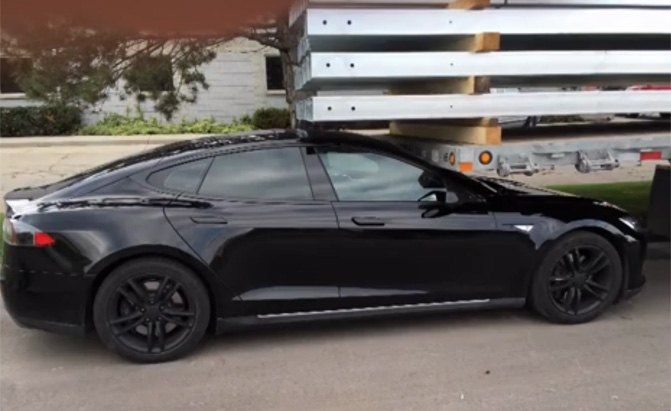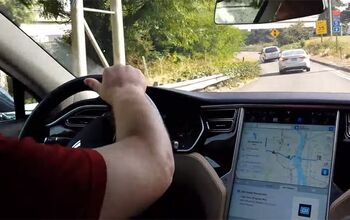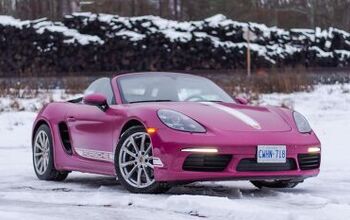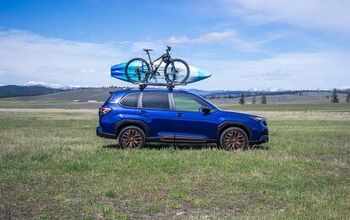Did This Tesla Model S Crash Itself?

A Tesla Model S owner in Utah is claiming that his vehicle moved on its own and crashed into a trailer.
According to Jared Overton, the owner of the Model S seen above, he was running errands on April 29 when he parked the Model S well behind a trailer. He then spoke to a worker at a business on the side of the road, who was asking him multiple questions about the Model S. Overton said that he spent at least 20 seconds to as long as a minute standing near the car while talking to the worker before proceeding into the business.
About five minutes later, Overton came back outside to see that his Tesla Model S had crashed under the trailer that was in front of him. He reached out to Tesla to report the issue and a week later, the American automaker responded with a letter suggesting that the accident was his fault. “Tesla has reviewed the vehicle’s logs, which show that the incident occurred as a result of the driver not being properly attentive to the vehicle’s surroundings while using the Summon feature or maintaining responsibility for safely controlling the vehicle at all times,” the letter signed by a regional service manager said.
SEE ALSO: Tesla Model 3 Design Not Yet Finalized
The Summon feature allows the Tesla Model S to park itself and Tesla claims it “was initiated by a double-press of the gear selector stalk button, shifting from Drive to Park and requesting Summon activation.”
Overton says that he does not believe he ever initiated the self-park function, added that even if he accidentally did, the vehicle should have started to park itself while he was standing next to it while talking to the worker.
Update: A Tesla spokesperson reached out to AutoGuide.com to clarify the incident, providing detailed facts and data on exactly what occurred, including a copy of the letter that was sent to Overton.
“The vehicle logs confirm that the automatic Summon feature was initiated by a double-press of the gear selector stalk button, shifting from Drive to Park and requesting Summon activation,” the letter sent to Overton said. “The driver was alerted of the Summon activation with an audible chime and a pop-up message on the center touchscreen display. At this time, the driver had the opportunity to cancel the action by pressing CANCEL on the center touchscreen display; however, the CANCEL button was not clicked by the driver. In the next second, the brake pedal was released and two seconds later, the driver exited the vehicle. Three seconds after that, the driver’s door was closed, and another three seconds later, Summon activated pursuant to the driver’s double-press activation request. Approximately five minutes, sixteen seconds after Summon activated, the vehicle’s driver’s-side front door was opened again. The vehicle’s behavior was the result of the driver’s own actions and as you were informed through multiple sources regarding the Summon feature, the driver is always responsible for the safe operation and for maintaining proper control of the vehicle.”
It’s important to note here that both Overton and Tesla have a reason to point their fingers at one another, but in this case, Tesla has data and logs with timestamps straight from the vehicle that show how the events unfolded.
In addition, the Tesla Model S Owner’s Manual goes into detail with numerous warnings and notifications regarding the limitations of the Summon feature and states that the driver must remain in control of the vehicle at all times, pay close attention and be prepared to take immediate action. The issue here is that Overton claims that he never activated the Summon feature and that he was unaware the Summon feature was even activated, saying that he stood near the vehicle between 20 seconds to a minute before leaving it.
Unfortunately outside of having cameras capturing exactly how the incident unfolded, it’s difficult to paint an accurate picture of exactly what happened. But at the end of the day, it’s unlikely that Tesla’s data is inaccurate, especially when it’s timestamped down to the second.
Here is an official statement concerning the accident from a Tesla spokesperson:
“Safety is a top priority at Tesla, and we remain committed to ensuring our cars are among the absolute safest vehicles on today’s roads. It is paramount that our customers also exercise safe behavior when using our vehicles – including remaining alert and present when using the car’s autonomous features, which can significantly improve our customers’ overall safety as well as enhance their driving experience.
Summon, when used properly, allows Tesla owners to park in narrow spaces that would otherwise have been very difficult or impossible to access. While Summon is currently in beta, each Tesla owner must agree to the following terms on their touch screen before the feature is enabled:
This feature will park Model S while the driver is outside the vehicle. Please note that the vehicle may not detect certain obstacles, including those that are very narrow (e.g., bikes), lower than the fascia, or hanging from the ceiling. As such, Summon requires that you continually monitor your vehicle’s movement and surroundings while it is in progress and that you remain prepared to stop the vehicle at any time using your key fob or mobile app or by pressing any door handle. You must maintain control and responsibility for your vehicle when using this feature and should only use it on private property. “
[Source: KSL]
Discuss this story on our Tesla Forum

Jason Siu began his career in automotive journalism in 2003 with Modified Magazine, a property previously held by VerticalScope. As the West Coast Editor, he played a pivotal role while also extending his expertise to Modified Luxury & Exotics and Modified Mustangs. Beyond his editorial work, Jason authored two notable Cartech books. His tenure at AutoGuide.com saw him immersed in the daily news cycle, yet his passion for hands-on evaluation led him to focus on testing and product reviews, offering well-rounded recommendations to AutoGuide readers. Currently, as the Content Director for VerticalScope, Jason spearheads the content strategy for an array of online publications, a role that has him at the helm of ensuring quality and consistency across the board.
More by Jason Siu
































Comments
Join the conversation
Tesla fatigue is not going away
Yes